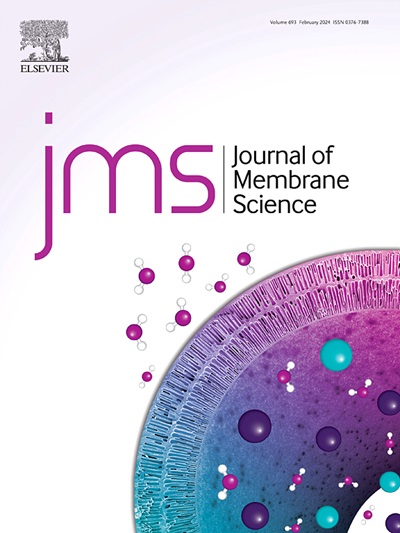(Pr,Ba) feo3基钙钛矿材料的氧离子输运:氧渗透性实验结果
IF 8.4
1区 工程技术
Q1 ENGINEERING, CHEMICAL
引用次数: 0
摘要
含铁钙钛矿材料作为固体氧化物燃料电池(SOFCs)和固体氧化物电解电池(SOECs)的电位电极材料,在高温电化学领域受到了广泛的关注。它们属于无钴材料家族,具有高氧化还原稳定性,可接受的热膨胀行为和良好的电子导电性。然而,为了设计用于氧还原和进化反应的电化学活性电极,铁基材料的氧离子电导率也必须很高。通过氧渗透实验,研究了掺杂效应(Pr0.6Ba0·0.4 fe0.9 m0.1 o3 -δ, M = Ni, Cu和Co)和外部参数对PBF (Pr0.6Ba04FeO3 -δ)氧离子输运行为的影响。通过带压延法成功制备了致密层厚度为~ 100 μm的三层|致密|多孔膜,并对其进行了电化学表征。结果表明,碱性PBF膜的透氧通量最高,而含钴膜的透氧通量较差。掺杂镍和铜的PBF材料在渗透性能和衍生的氧离子电导率方面处于中等水平。这些数据,以及通过掺杂定制的其他功能特性,使含Ni和cu的材料成为(Pr,Ba)FeO3 - δ最有希望用于电化学应用的衍生物之一。本文章由计算机程序翻译,如有差异,请以英文原文为准。

Oxygen-ionic transport of (Pr,Ba)FeO3-based perovskite materials: Results from oxygen permeability experiments
Fe-containing perovskite materials have attracted considerable attention in the field of high temperature electrochemistry as potential electrode materials for solid oxide fuel cells (SOFCs) and solid oxide electrolysis cells (SOECs). Belonging to the cobalt-free family of materials, they exhibit high redox stability, acceptable thermal expansion behavior, and good electronic conductivity. However, in order to design electrochemically active electrodes towards oxygen reduction and evolution reactions, the oxygen-ionic conductivity of the iron-based materials must also be high. In the present work, the oxygen-ion transport behavior of Pr0.6Ba04FeO3–δ (PBF) was comprehensively investigated by oxygen permeation experiments as a function of doping effects (Pr0.6Ba0·.4Fe0.9M0.1O3–δ, M = Ni, Cu, and Co) and external parameters. In detail, three-layer porous|dense|porous membranes with a dense layer thickness of ∼100 μm were successfully prepared by the tape calendaring method followed by their electrochemical characterization. It was found that the highest oxygen permeation fluxes were obtained for the basic PBF composition, while the Co-containing membrane showed the inferior permeation properties. The Ni- and Cu-doped PBF materials were intermediate in permeation properties and derived oxygen-ionic conductivity. These data, together with other functional properties tailored by doping, make Ni- and Cu-containing materials one of the most promising derivatives from (Pr,Ba)FeO3–δ for electrochemical applications.
求助全文
通过发布文献求助,成功后即可免费获取论文全文。
去求助
来源期刊

Journal of Membrane Science
工程技术-高分子科学
CiteScore
17.10
自引率
17.90%
发文量
1031
审稿时长
2.5 months
期刊介绍:
The Journal of Membrane Science is a publication that focuses on membrane systems and is aimed at academic and industrial chemists, chemical engineers, materials scientists, and membranologists. It publishes original research and reviews on various aspects of membrane transport, membrane formation/structure, fouling, module/process design, and processes/applications. The journal primarily focuses on the structure, function, and performance of non-biological membranes but also includes papers that relate to biological membranes. The Journal of Membrane Science publishes Full Text Papers, State-of-the-Art Reviews, Letters to the Editor, and Perspectives.
 求助内容:
求助内容: 应助结果提醒方式:
应助结果提醒方式:


